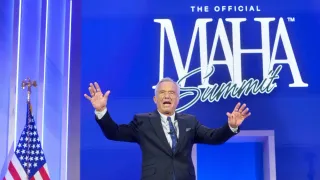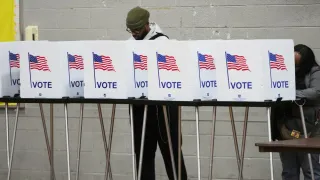November 20, 2015
'Years Yet Yesterday' Exhibit Commemorates Larry Kramer's Call to Action
Winnie McCroy READ TIME: 8 MIN.
On Friday, November 20 from 7-9 p.m. in Chicago, artist Mark Addison Smith welcomes the community for the opening night reception of his art exhibition,�"Years Yet Yesterday," at the Center on Halsted's 2nd floor gallery.�
The exhibition consists of an abecedary of 24 text-based drawings inspired by playwright and activist Larry Kramer's 2004 call-to-action speech, "The Tragedy of Today's Gays." Each drawing is dedicated to a letter in the alphabet, and drawn using three words, rewritten hundreds of times, that appear in the original speech (the complete set contains 24 works because Kramer's speech did not include any words beginning with an X or a Z).
This series was completed to commemorate the 10th anniversary of Kramer's speech, with hopes of inviting viewers to reflect upon a decade-long sliver of the 30+ ongoing years of the AIDS crisis. The drawings first began in Chicago in 2010 and Addison completed them in New York City in 2014. So, this Chicago exhibition completes the series, full-circle. The original, framed works will be for sale, as well as a limited-edition artist's book featuring reproductions of the entire series.
Smith took time to chat with EDGE about the inspiration for this exhibit, and why it ties in so well with World AIDS Day commemorations.
EDGE: How did Larry Kramer's 2004 speech inspire you to mount this show?
Smith: I first discovered a paperback copy of Larry Kramer's 2004 speech, "The Tragedy of Today's Gays," in 2010 at The Brown Elephant resale store in Andersonville, where my partner and I used to live (we now live in New York City... I'm a professor at The City College of New York in Harlem). The title really spoke to me, as a gay man and as a member of the LGBTQ community that is always facing these roller coaster moments of strides and adversity.
As an artist who primarily works with text, I decided to zero in on Larry Kramer's words as my entry-point for a drawing series, because they are so biting and charged and direct. He wants to wake up his audience. The circular format just emerged, instinctively, from the first drawing. I read the speech and thought about colorblind eye charts, since Kramer is challenging the gay community to 'see' amidst all of the messy shades of gray. As subsequent drawings developed, I subconsciously thought about the round form emulating the globe, or even petri dishes and viral shapes, and, diving deeper, down to conceptual issues of unity and closure -- emotional elements we're seeking amidst this crisis.
EDGE: Why did you break it up into 24 letters?
Smith: I decided to break apart the speech into an abecedary -- an alphabet-based series -- because it allowed me the chance to bring order to both Larry Kramer's words and the gay community, versus the political chaos and sense of community disharmony that is outlined by Kramer in his speech. The speech was first given on November 7, 2004 to the LGBTQ community days following the reelection of George W. Bush, a low point for the gay community from both a health-advocacy and self-preservation stance. In the speech, Larry Kramer declares to the crowd, "We have lost the war against AIDS." Kramer is hard-hitting in holding the gay community responsible for not operating as a stronger front. His solution against this 'lost war' is for allies to band together in a way they have never united before: to speak up for reform and to shake up one another as a force field for visibility, inclusivity, equal rights and AIDS-related reform.
Within my art practice, I like rules and organization -- and chaos can, surprisingly and wonderfully, erupt within this structured environment. Using Kramer's speech as an entry point, I began by considering the alphabet and grayscale messiness that happens when voices and opinions come together. Unpacking the speech into an alphabetic system takes us to back to a purity and simplicity that harkens an elementary-level of understanding (in this case, the system that is being explored is the last 10 years of the AIDS crisis). However, the words that I've extracted and rejoined together from Kramer's speech (such as Expected Elected Emergencies or Wrong Way Washington or Political Plague Pigshit), suddenly become very complicated and difficult to resolve when juxtaposed as lenses against the past 10 years of this crisis.
From a semiotic level, the word AIDS contains four innocent letters that converge together to signify the messiness of lives, loss, emotion, histories, policy, stigma, misunderstanding, research, power, you name it -- within America and across the globe. Parsing out Larry Kramer's words into an alphabetic system brought an analytical level of artistic research to the speech, which allowed me to research trends in his language, from an abundance of his repeating phrases or words to words that are absent or barely spoken. Kramer's two most frequently used words are 'I' (spoken just over two-hundred times) and 'you' (spoken just under two-hundred times). It makes sense that these two words appear with the most urgency, given that true reform for the the AIDS crisis will only truly happen as a construct between ourselves and others -- whether that be a community-based or nation-wide outreach.
Another word that appears with frequency is 'cabal.' This single word drives Kramer's overall tone for the speech, as he's defining the institutions, including the Republican Administration, politicians, health care providers, a heteronormative majority, or even unaware gay men, who are undermining... or, murdering, to use his direct language... our ability as a marginalized community to take primary action.
EDGE: What are examples of some of the pieces or detail in pieces inspired by this?
Smith: The drawings are constructed so that they can be read from front to back or back to front in order to question the last ten years of the 30+ years of the AIDS pandemic. Each drawing contains three words from Kramer's 2004 speech. These words are rewritten hundreds of times to push the emphasis of meaning within a single word, similar to Kramer's call-to-action goal within his hard-hitting speech. The rules of each drawing exist within a conflicting binary: the larger, foreground word is in disagreement against the smaller, background words, while the middle, fill-in words serve as mediator. By reading the statements back to front or front to back, the viewer, hopefully, will consider then versus now and the grayscale complexities of this ongoing crisis.
The title for the complete series is "Years Yet Yesterday," which is also the phrase from the Y drawing. It's the last alpha-order drawing in the series, since there are no Z words spoken in Kramer's speech. I chose that title because it speaks to the time-element depicted within this series: a decade of reflection or the passage of time in the blink-of-an-eye, but it also serves as a subtle reminder -- if you read it front to back or back to front -- that the AIDS crisis is far from over. But, hopefully, we're still fighting.
I'm also drawn to the binaries within the R drawing: "Research Requires Response," the W drawing: "Wrong Way Washington," and the M drawing: "Miraculous Meds Maybe." All three of these, if read forward and backward, are provocative lenses for viewing progress and research over the past 10 years. Since Kramer's speech, we've left the Bush administration and entered into the Obama administration, whom Out Magazine just named ally of the year. And, the White House just released the National HIV/AIDS Strategy five-year plan for the United States, which will hopefully increase access to better care and health outcomes, but we will see.
EDGE: How does a time-element inform the drawing series?
Smith: Within the speech, Kramer doesn't use any words that begin with an X or a Z, which cuts the abecedary down to 24 drawings. At first, I was frustrated by these missing drawings. But, in a lightbulb moment, I realized that the 24 drawings become a symbol for time: 24 hours in a day, cumulative days adding up to months and years, years leading to a decade. Time, specifically urgency, is at the heart of Kramer's speech: we must act now. And this time element extended to my artistic practice, as well, since I was working non-stop to complete the drawings in advance of the November 7th 10-year anniversary of the speech. I completed the last drawing, "L-Leader Loses Lover," on Wednesday night, November 5, 2014, just two days shy of the November 7th anniversary date when Larry Kramer first addressed his crowd at New York City's Great Hall at Cooper Union in 2004.
EDGE: Why was it important to you to commemorate World AIDS Day with this installation?
Smith: The Center on Halsted is an anchor for the LGBTQ community and I was eager to display the work within their gallery for two reasons: My partner and I used to live in Chicago and I first began working on the series there, so a return to base-camp for this work was of interest to me. Secondly, I wanted to display the work within an arena in which health advocacy, community care, strides in public awareness, and conversations about research across the LGBTQ political climate are taking place. That's happening at the Center. So, it's of deep value to me to exhibit this work, which also asks the viewer to consider these complicated shades of gray as they relate to AIDS advocacy and LGBTQ visibility in a space which can deepen the context and conversation of the work. I'm quite honored that David Joseph, the Center on Halsted gallery curator, invited me to exhibit the work as their 2015 World AIDS Day exhibit.
EDGE: Why its it important to keep the AIDS crisis at the forefront of our minds?
Smith: Until the AIDS crisis is eradicated, we won't be able to remove this from the forefront of our minds, and we shouldn't. What began as a gay crisis between the initial 41 cases of HIV-infected men (the 'rare cancer' as described by The New York Times in their July 3, 1981 article) has now become a crisis of humanity. I always think of personal histories -- the individuals and their families, friends, lovers, which should be honored within our collective memory.
EDGE: Where will it be shown next?
Smith: The Center on Halsted exhibition is the inaugural showcase for the complete set of 24 drawings, and the last time I will maintain the full set because I'm offering the framed works for sale at the exhibit. Drawings can be purchased through the Center on Halsted until January 5, 2016.
I've grown quite attached to the set of drawings; artists have a kinship with their work. Here, each drawing, with the repetition of three words drawn over and over, represents not only a passage and investment of my time but also quite a bit of consideration about LGBTQ kinship, contemporary crisis and a need for communication as a marginalized community. The drawings -- and Kramer's speech -- spoke to me and I hope they speak to the public.
"Years Yet Yesterday" opening reception will be held from 7-9 p.m. on Friday, November 20 at the Center on Halsted 2nd Floor Gallery. 3656 N. Halsted St., Chicago. The show runs November 20-January 5, 2016.
For more information, visit markaddisonsmith.com






